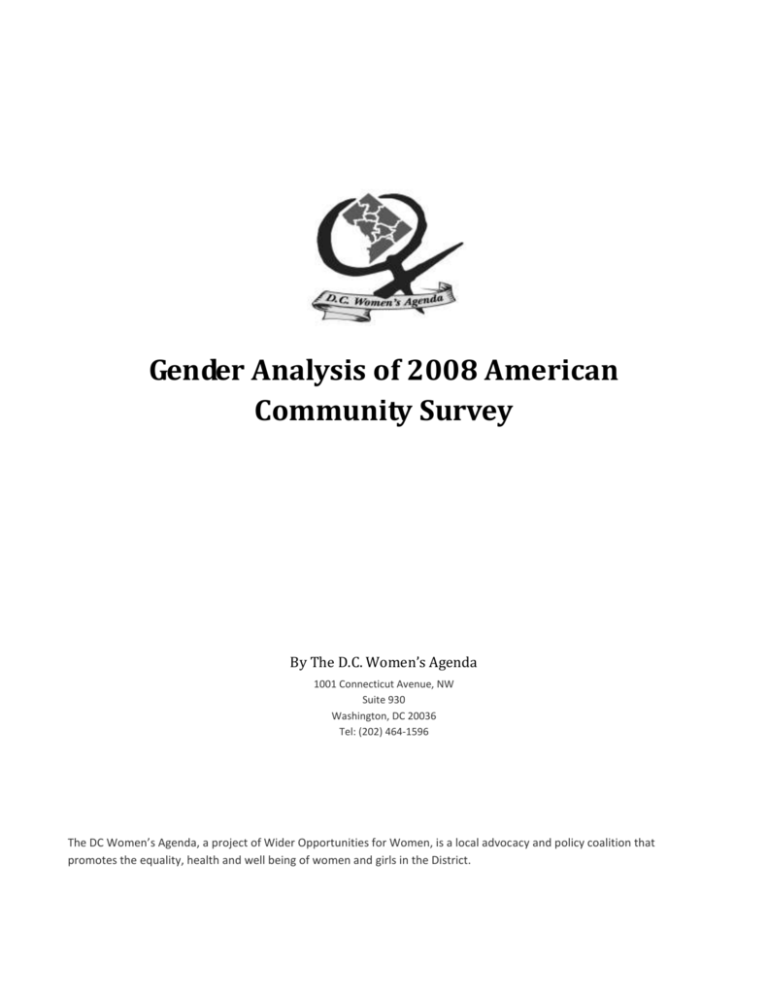Educational Attainment in DC by Gender
advertisement

Gender Analysis of 2008 American Community Survey By The D.C. Women’s Agenda 1001 Connecticut Avenue, NW Suite 930 Washington, DC 20036 Tel: (202) 464-1596 The DC Women’s Agenda, a project of Wider Opportunities for Women, is a local advocacy and policy coalition that promotes the equality, health and well being of women and girls in the District. INTRODUCTION As part of its ongoing mission to advocate for women and girls in the District of Columbia, the DC Women's Agenda (DCWA) gathered data from the 2008 American Community Survey (a division of the US Census) to examine patterns in income earnings, education, and poverty based on gender1. We explored how employment impacts poverty for men and women. The findings of this particular analysis reaffirm some historical gaps between the genders but also reveal some interesting new data. We hope this research will inform decision-makers as they seek to maximize the self-sufficiency potential of our women and girls. Median Earnings in D.C. by Gender The graph below illustrates the disparity in earnings between the sexes for 2008. Median earnings for women in DC in 2008 was $36,987 whereas the median earnings for men in DC was $43,391. This represents a 17% earnings premium for men over women. Men working full-time, year round had median earnings of $57,393 while women working full-time, year round had median earnings of $50,519. Interestingly, women who occupy part-time or intermittent positions make $740 more per year than men in part time or intermittent positions. This is probably due to the fact that woman often hold part-time jobs as their primary source of income because of other family obligations. Male full-time, year-round workers experienced a 8.58% change in median earnings from 2007 to 2008 while female full-time, year-round workers experienced only a 2.34% increase. However, when all employees, fulltime, part-time and intermittent, are taken together, men’s median incomes increased 3.27% while women’s increased 5.57%. This is due to the fact that part time/intermittent male workers’ earnings decreased 34.07% from 2007-2008 while the earnings of women who worked part time or intermittently from 2007-2008 decreased only 21.08%. 1 In certain circumstances we added race as a variable. Source: American Community Survey Table B20017, 2007 and 2008. Earnings in D.C. by Educational Attainment and Gender The graph below examines earnings by gender based on educational attainment. The data indicates that higher levels of education for both genders result in higher earnings. Nevertheless, at each educational level, women receive less money than men. As earnings and educational attainment decrease, the disparity in earnings between both men and women is diminished, unless they have less than a high school education. In 2008, the median earnings for women who have a graduate degree was $70,787, whereas the median earnings for men with a graduate degree was $96,640. The median earnings for women who have a bachelor’s degree was $50,995, whereas the median earnings for men with a bachelor’s degree was $65,432. The median earnings for women with some college was $33,450, whereas the median earnings for men with some college was $45,595. The median earnings for women with a high school degree was $28,848, whereas the median income for men was $29,728. Source: American Community Survey Table S2001, 2008.Earnings in D.C. by Educational Attainment and Gender (cont.) Women’s median earnings rose from 2007 to 2008 for each level of educational attainment . In comparison, men’s earnings rose from 2007 to 2008 for those with graduate degrees, bachelor’s degrees, and some college or an associate’s degree, but not for those with a high school degree or less. * includes equivalency Source: American Community Survey Table S2001, 2007.Educational Attainment in D.C. by Gender There are more women than men at each level of educational attainment. White women hold bachelor’s degrees more than three times as often as their Black female peers and hold graduate degrees more than four times as often as that same group. In addition, there is a large differential between Black men and women who earn far fewer graduate and bachelors’ degrees than White men and women. The differential reverses itself after college with more Black men and women having associate degrees, some college, GED, high-school diplomas and no diplomas than their White counterparts. Source: American Community Survey Table C15002. Source: American Community Survey Tables B15002A and B15002B. Household Types in D.C. The American Community Survey figures also provide a staggering portrait of the situation of families living in the District. Single-parent headed households are primarily run by women. Of single-headed households in D.C., 81.21% are women-headed households and 18.79% are male-headed households. Thus, women are four times more likely to be single heads-of-households than men in D.C. Source: American Community Survey Table B11001A and B11001B. The disparity in race among single-parent households is particularly stark. White women are single heads-of- households 27.2% more often than White men, whereas Black women are single heads-of-household 143.1% more often than Black men. Families Living Below the Poverty Level in D.C. Work is not a barrier for families living in poverty. More than 22% of single women-headed households with one worker in the family working full-time or part-time live below the poverty line.2 Approximately 6% of womenheaded households in which the woman works full-time year-round live below the poverty line. Source: American Community Survey – Table S1702, 2008. Families Living Below the Poverty Level in D.C. (cont.) 2 The American Community Survey defines “worker” as a person 16 years old and over who worked one or more weeks for pay or profit (including paid vacation and paid sick leave) or worked without pay on a family farm or in a family business. Single women with children under the age of 18 are eight times more likely to be living below the poverty line than their married women counterparts. In fact, 34.9% of women single head-of-households with children under the age of 18 live below the poverty line. Alarmingly, DC has the greatest percentage of single families with children than any other state (21.1% compared to a national average of 8.4%). Although the percentages of families below the poverty level have dropped from 2007 to 2008, single womanled families have declined at the lowest rate. Only 8.4% of single-women headed households broke through the poverty line from 2007 to 2008, whereas 37.3% of married women with children broke through the poverty line. Source: American Community Survey – Table DP-3, 2007 and 2008. CONCLUSION Income earning has traditionally been gender-biased; not surprisingly, the survey indicates that men’s median income is greater than women’s even when educational attainment is the same. The situation for single women heading households with children is particularly troubling. These women are eight times more likely to live in poverty than their married counterparts. Work is not a barrier against poverty for many of these families – 22% of single women-headed households with one worker in the family working full-time live in poverty. Approximately 6% of women-headed households in which the woman works full-time, year-round live below the poverty level. Moreover, women in the District did not make any significant income gains from 2007 to 2008. In fact, in some instances the disparities between the genders grew. For example, men who worked full time had an 8.5% increase in salary from 2007-2008, where their female counterparts had a 2.3% increase. Although the percentage of families below the poverty level decreased from 2007 to 2008, the percentage of woman-headed households in poverty declined the least. Only 8.4% of single-woman-headed households moved above the poverty line from 2007 to 2008, whereas 37.3% of married women with children surpassed it. Increases in the spouse’s income in the two-adult families was a contributing factor to their decreasing poverty rate, whereas single women heading households with children did not make the same improvements in their income. What do these findings suggest for those working to improve the economic security of women and girls in our nation’s capital? We must make sure that decision-makers are aware of these findings and address them in policymaking and funding decisions.. Because we see so many women in DC working – we remain unaware that they are paid less than men. Because we see women receiving educational degrees – we remain unaware that their degrees will not have the same earning power as their male counterparts. Because we see women in the workforce – we remain unaware that many working women still live in poverty. It is our hope that this analysis will provide key District leaders with information they need to make the informed policy choices – choices to help women achieve parity with men and truly move towards self-sufficiency. The DC Women’s Agenda is committed to using this research to improve economic self-sufficiency for our city’s women and girls. A concerted campaign to partner with other community stakeholders, Mayor Fenty, the DC Council, and District agencies will be an essential, ongoing component of these efforts.








